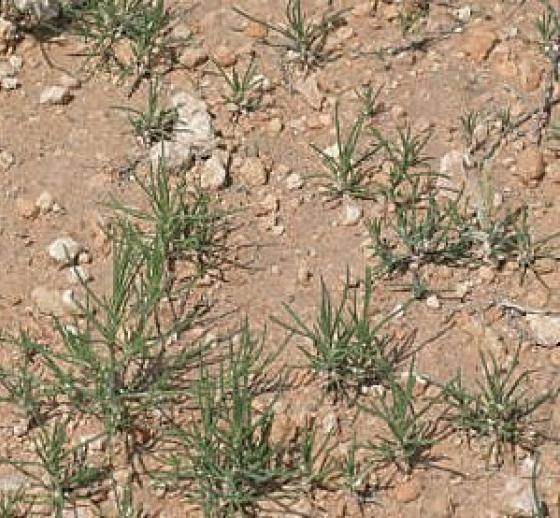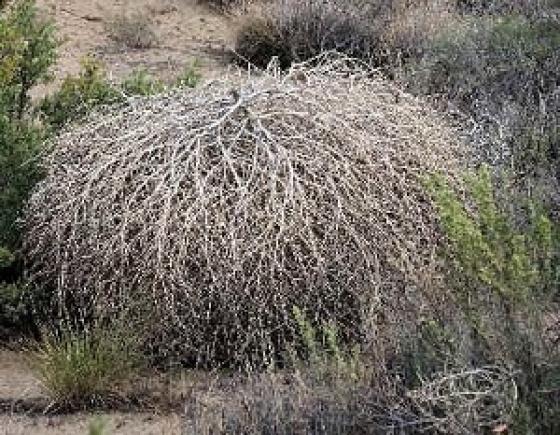Scientific Name:Salsola kali (also Salsola tragus and Salsola iberica)
Family: Chenopodiaceae (Goosefoot Family)
Other common names: tumbleweed, prickly Russian thistle
Life-Cycle: Annual; spreads only from seed
Weed Guide > Russian Thistle
Russian Thistle
| Description | Bloom (varies by elevation) |
What to Do | When? | Invades Undisturbed Land | State Class |
|---|---|---|---|---|---|
| Slender, fleshy seedlings; red-striped stems; becomes 2-3 ft tall, prickly and woody then breaks off as a tumbleweed. | Small, petal-less bloom of white or pink occurs up the length of the stem at each spiny leaf in July & August. | Hand pull or hoe seedlings; cultivate soil; plant competing vegetation. | June through August. | Typically no. Needs loose, disturbed soil to germinate; is most common along roads, trails and driveways. | None. |

General Description
- Russian thistle is least noticed when it is young - slender, green and soft - and most noticed when it's a large, spiny, brown tumbleweed.
- Flexible, almost succulent, green (or sometimes pink) stems have red/purple vertical stripes, and are multi-branched to the point ofbecoming a bushy bramble as plant grows.
- Fine, long leaves that look like soft pine needles are reduced to short, prickly spines as the plant ages over the summer.
- Tiny flowers are basically unnoticeable without close inspection, but they are attached directly to the stem, white to pink and relatively attractive.
- Russian thistle does not like firm, well-irrigated soil (around your house); look for broken chunks of dried Russian thistle along roads, driveways and trails.

Life-Cycle
- An annual, each plant dies every year and new plants grow from seed.
- Germinates between late April and August; flowers late June through August; goes to seed August to November; dies after the first fall frost and breaks at the base of the stem now through the following spring to spread seed as a tumbleweed.
- Seeds need loose soil and are not viable for more than a year or so (meaning, you can beat this weed!).
Prevention & Control
Prevent
- Detect and eradicate new plants early; look for last year's tumbleweeds as a clue.
- Do not drive vehicles and machinery through areas with old tumbleweeds.
- Screen irrigation water before it enters a field or your irrigation pipes.
Hand Pull
- Hand-pulling or hoeing is the best and easiest method for small or sporadic patches as the roots are shallow and the plant grows from seed (not roots).
- Seeds germinate throughout the spring and summer so check your property often.
Mowing, Grazing Cultivation and Biocontrols
- Mowing or otherwise destroying young plants prevents seed production.
- Planting competitive desirable species, such as tall grass or shrubs can effectively shade out sunlight and suppress weed seedlings.
- Grazing works well for young plants.
- Several potential biocontrols are under investigation but none exist now.
See the whole “Toolbox of Weed Control Methods” for more details.
Interesting Tidbits
- Russian thistle is the primary host for the beet leafhopper (Circulifera tenellus) that carries the "curly-top virus" of sugar beets, tomatoes, squashes, melons and cucumbers.
- Russian thistle tumbleweeds present a serious fire hazard.